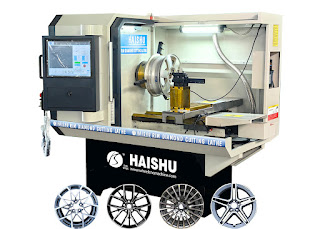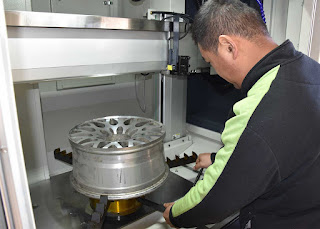Buckled Alloy Wheel Repair: Ensuring Safety with Precision Equipment
Alloy wheels are not just a stylish addition to a vehicle; they are crucial in ensuring a smooth and safe driving experience. However, various external factors such as uneven road surfaces, potholes, or impacts from rocks can cause alloy wheels to deform. If not addressed promptly, such deformation can adversely affect a vehicle’s stability and safety. In this article, we will explore how to utilize a wheel repair lathe to repair deformed alloy car wheels.
The Process of Alloy Wheel Deformation Repair
Step 1: Wheel Disassembly and Tire Removal
Initially, the alloy wheel must be removed from the vehicle, followed by the tire being dismounted using a tire changer machine. This step is crucial for gaining access to the damaged area of the wheel.
Step 2: Wheel Straightening
Next, the wheel is mounted on a wheel repair machine, often referred to as a wheel straightening machine. This device rotates the wheel to pinpoint the exact location of the deformation. By heating the deformed area to soften it, hydraulic tools attached to the machine can then straighten the wheel. A dial indicator is used to verify the straightening results, and this process may be repeated as necessary, typically lasting about 5-10 minutes.
Step 3: Precision Machining with a Wheel Repair Lathe
After straightening, the wheel is affixed to a wheel repair lathe. A laser probe scans the wheel’s surface to collect data, which the lathe’s automatic optimization function uses to generate a precise machining program. The lathe employs an automatic tool setter to determine the machining starting point. The wheel is then carefully cut to restore the surface to the original standards.
Step 4: Polishing and Painting
For wheels with minor scratches, a polishing machine can be used to smooth out imperfections. After polishing or cutting, the wheel is cleaned, and a clear coat is applied. Alternatively, wheel painting equipment can be used to apply a fresh coat of paint before the wheel is cured in an oven. Wheel electroplating is another option to give the wheel a new lease on life.
Tai’an Haishu Machinery: Your Ally in Wheel Refurbishment
Tai’an Haishu Machinery is a premier manufacturer specializing in automotive wheel refurbishment and repair equipment. Our extensive product line includes wheel straightening machines, wheel repair lathes, wheel CNC machines, wheel ovens, wheel painting booths, and tire changers. With over 50 global sales agents and partnerships in more than 100 countries, our wheel repair machines are easily accessible, whether they are directly produced by us or custom-branded for our clients.
For tailored wheel CNC machines or wheel repair lathes specific to your needs, we invite you to contact us. We are dedicated to working with you to provide professional solutions for buckled alloy wheel repair.
By integrating advanced wheel repair lathes, wheel repair machines, wheel CNC machines, and wheel straighten machines into the repair process, buckled alloy wheel repair becomes an optimized solution for safety and stability. Ensure the longevity and performance of your vehicle by choosing the right equipment and expertise for alloy wheel restoration.







